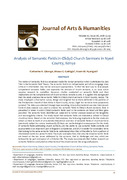| dc.description.abstract | The notion of semantic field is a structural model for lexical semantics which is attributed to Jost Trier in the Semantic Field Theory. The semantic field is an indispensable part of any language since without it information may not be conveyed appropriately. To find the best way to help people comprehend semantic fields, and especially the domain of church sermons, is an issue which requires research to crystallize. However, studies conducted on semantic fields and their implications on the comprehension of church sermons remains scanty. It is against this background that the study analyses the semantic fields in Gĩkũyũ church sermons in Nyeri County, Kenya. The study employed a descriptive survey design and targeted live sermons delivered in 84 parishes of the Presbyterian Church of East Africa in Nyeri County, Kenya. Eight live sermons were purposively sampled. The data was collected through tape recording. A lexical semanticist was also interviewed.
Content data analysis was used to analyse the semantic fields in Gĩkũyũ church sermons. Data is presented in tables in which Gĩkũyũ semantic fields used in the sermons are listed and their gloss provided. The semantic fields identified are subjected to further analyses based on the tangibility and non-tangibility criteria. The study found that semantic fields are elaborately utilized in Gĩkũyũ church sermons. Based on the semantic field analyses, the following implications for the study are noted: (i) there is merit of an extensive theoretical overview of semantic fields of church sermons (previously subject to cursory treatment), (ii) there are methodological consequences for the study of semantic fields addressing church sermons, (iii) the ability to use semantic fields correctly and
appropriately is an important part of linguistic competence, and (iv) it is easier for vocabulary items that belong to the same semantic field to be understood since they will be able to form a pattern of interrelated words in a person’s mind. The study concludes that, inter alia, the broad semantic fields are based on the key issues addressed by the sermons, that is, challenges and sins, which are believed to be part and parcel of a Christian life. The study recommends that further research on semantic fields be conducted on other items of the church service like songs and prayers. | en_US |
